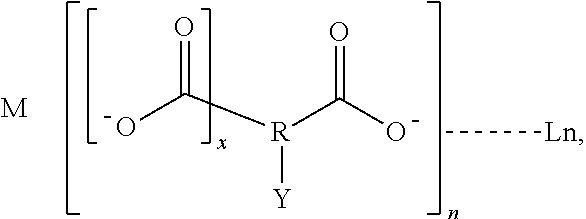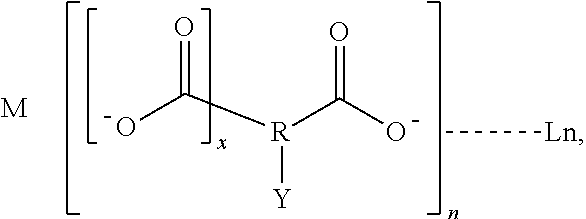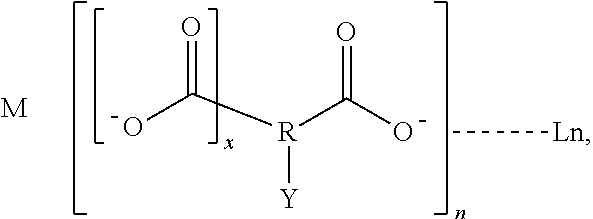Luminescent lanthanide complex, and articles and inks containing the luminescent complex
a technology of luminescent lanthanide and complex, which is applied in the field of security documents, packaging or items of value, can solve the problems of increasing the difficulty of making a clear distinction between fake documents and originals, high counterfeiting of paper related documents, and even recent diplomas, etc., and the level of security of diplomas made with paper is not enough to prevent illicit reproduction
- Summary
- Abstract
- Description
- Claims
- Application Information
AI Technical Summary
Benefits of technology
Problems solved by technology
Method used
Image
Examples
example 1
Synthesis of 4-chloropyridine-2,6-dicarboxylic acid (Cldpa)
[0106]To a solution of dichlorophenyl phosphine oxide (1.492 mol, 290.8 g) at 120° C. slowly add under stirring chelidamic acid (0.373 mol, 75.0 g). Heat the reaction mixture at 120° C. for 2 hr under an inert atmosphere. Take care to avoid a too-fast formation of foam. After cooling at 80° C., the reaction mixture is poured into H2O (1 L). By gradually pouring, the reaction mixture can turn solid. The solid is filtered, washed twice with H2O and dried overnight at 70° C. (97%).
[0107]1H NMR [(CD3)2SO]: δ 8.24 (s, 2H)
example 2
Synthesis of 4-pyrrolidinopyridine-2,6-dicarboxylic acid (Pyrrodpa)
[0108]4-chloropyridine-2,6-dicarboxylic acid (0.238 mol, 48.0 g) is slowly added under stirring to a solution of pyrrolidine (0.952 mol, 67.8 g) at room temperature. Take care to avoid a too-fast addition leading to local temperature increase. Observe precipitation of a solid. The reaction mixture is heated at 120° C. for 2 hr. By gradually heating, the reaction mixture becomes solid. After cooling at 60° C., H20 (80 ml) is added and the mixture is stirred for 30 min until the solid is completely dissolved. The solution is then acidified with HCl (2M) until pH=1. The formed precipitate is filtered, washed twice H2O and dried overnight at 70° C. (93%).
[0109]1H NMR [(CD3)2SO]: δ 7.25 (s, 2H), 3.44 (t, 4H), 2.01 (t, 4H)
example 3
Synthesis of 4-Morpholino-pyridine-2,6-dicarboxylic acid (Morphodpa)
[0110]4-chloro-pyridine-2,6-dicarboxylic acid (0.025 mol, 5.0 g) is slowly added under stirring to a solution of morpholine (0.250 mol, 21.6 g) at room temperature. Care is taken to avoid a too-fast addition leading to local temperature increase. Precipitation of a solid is observed. The reaction mixture is heated at 120° C. for 2 hr. By gradually heating the reaction mixture becomes solid. After cooling at 60° C., H20 (80 ml) is added and the mixture is stirred for 30 min. until the solid is completely dissolved. The solution is then acidified with 2M HCl until pH=1. The formed precipitate is filtered, washed twice H2O and dried overnight at 70° C. (70%)
[0111]1H NMR [(CD3)2SO]δ: 7.59 (s, 2H), 3.72 (t, 4H), 3.44 (t, 4H)
PUM
 Login to View More
Login to View More Abstract
Description
Claims
Application Information
 Login to View More
Login to View More - R&D
- Intellectual Property
- Life Sciences
- Materials
- Tech Scout
- Unparalleled Data Quality
- Higher Quality Content
- 60% Fewer Hallucinations
Browse by: Latest US Patents, China's latest patents, Technical Efficacy Thesaurus, Application Domain, Technology Topic, Popular Technical Reports.
© 2025 PatSnap. All rights reserved.Legal|Privacy policy|Modern Slavery Act Transparency Statement|Sitemap|About US| Contact US: help@patsnap.com



